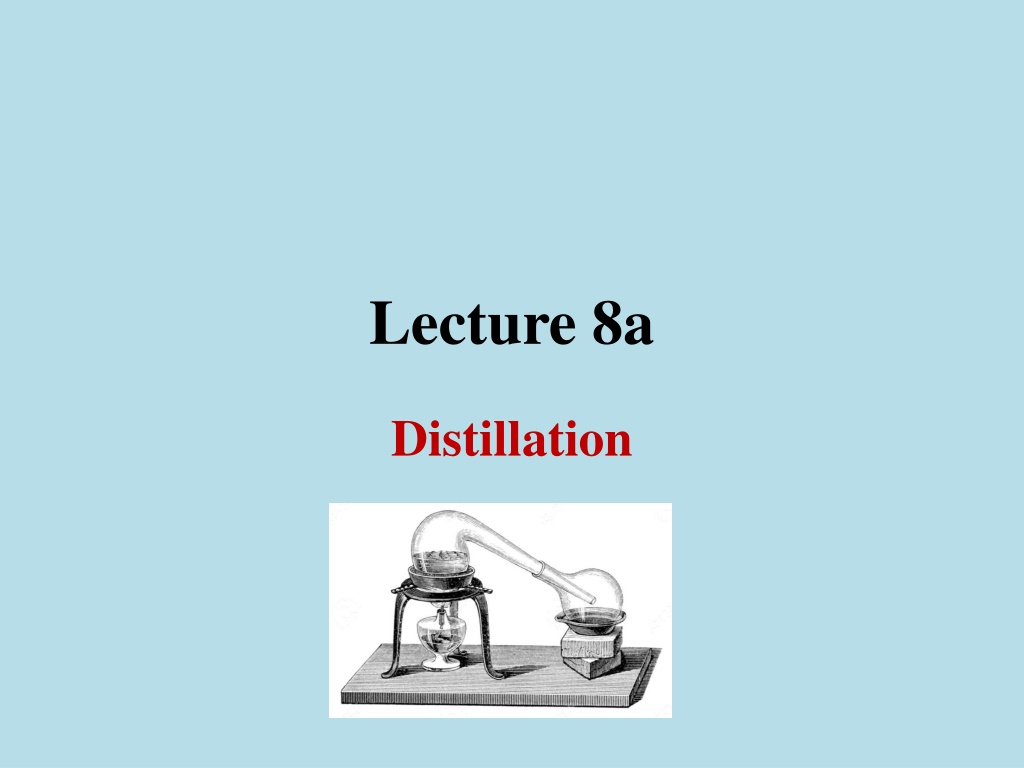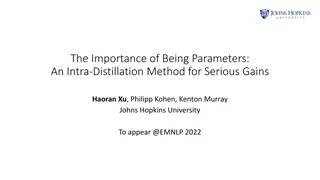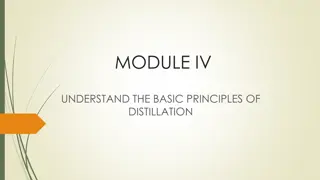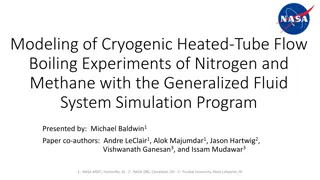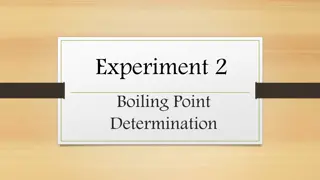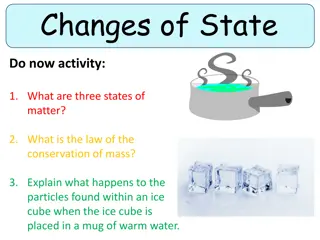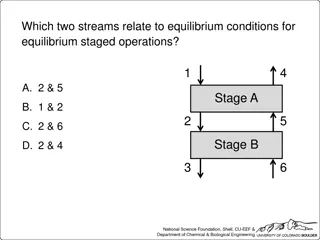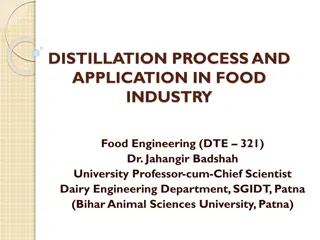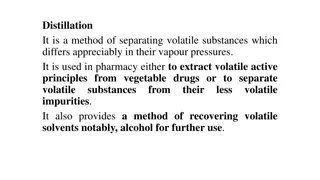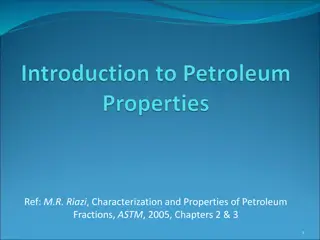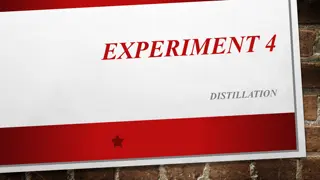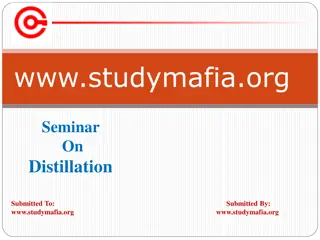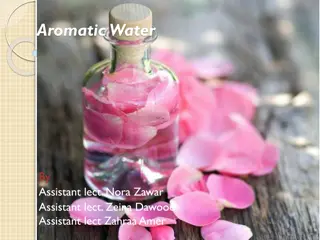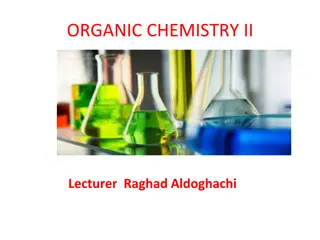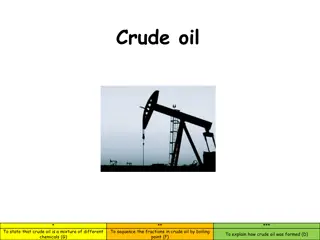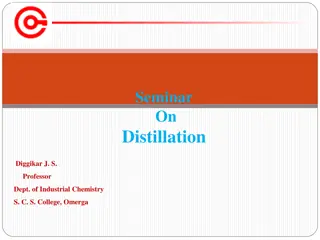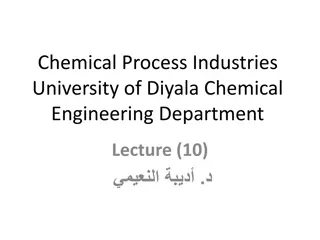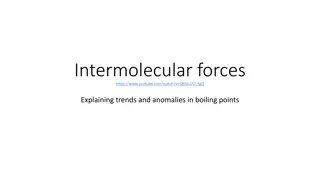Understanding Distillation: Methods and Factors Affecting Boiling Points
Distillation is a process used to separate liquids based on their boiling points, with methods like simple, fractional, vacuum, and steam distillation. The boiling point of a compound is influenced by factors such as molecular weight and functional groups, where higher weights and polar groups lead to higher boiling points due to stronger intermolecular forces. This article delves into the science behind distillation and the principles governing boiling points of compounds.
Download Presentation

Please find below an Image/Link to download the presentation.
The content on the website is provided AS IS for your information and personal use only. It may not be sold, licensed, or shared on other websites without obtaining consent from the author. Download presentation by click this link. If you encounter any issues during the download, it is possible that the publisher has removed the file from their server.
E N D
Presentation Transcript
Lecture 8a Distillation
Introduction What is distillation? A distillation is the process that includes the vaporizing a liquid from a pot and the subsequent condensation of the vapor and collecting the condensate in a receiver The evaporation is an endothermic process and requires heat (external or internal). The heat of vaporization is much lower than the bond energies (i.e., water: Hvap= 40.7 kJ/mol, Do(O-H)= 460 kJ/mol) The entropy increases during the phase transition ( Svap= 118.9 J/(mol*K)), which means that the volume expands a lot during the evaporation process The condensation is an exothermic process and therefore requires cooling (i.e., condenser to remove the heat) This technique is particularly useful for separating mixtures where the components have sufficiently different boiling points (i.e., diethyl ether-toluene, salt water)
Introduction Four distillation methods are available to the chemist: 1. Simple distillation Separating liquids boiling below 150 C at 1 atm. The liquids should dissolve in each other and the difference in boiling point between various liquid components should be at least 25 C (i.e., water from salt water solution). 2. Vacuum distillation Separating a liquid mixture boiling with boiling points above 150 C at 1 atm 3. Fractional distillation Separating liquid mixtures in which boiling points of the volatile components differ by less than 25 C from each other (i.e., gasoline) 4. Steam distillation This technique is mainly used to isolate oils from natural compounds (i.e., eugenol from cloves, eucalytus oil from eucalytus leaves, D-limonene from orange)
What determines the Boiling Point of a Compound? Which factors influence the boiling point in general? 1. Molecular weight The higher the molecular weight, the higher boiling point is as the following sequence shows: CH3CH2CH2CH2CH2CH3 CH3(CH2)8CH3 CH3(CH2)12CH3 CH3CH2CH2CH2CH3 CH3CH2CH2CH3 mw = 58 bp -0.4 oC mw = 142 bp 174 oC mw = 198 bp 252 oC mw = 72 bp 36 oC mw = 86 bp 69 oC While butane is a gas at ambient pressure (that is why it is stored in pressurized metal containers), pentane and hexane are low boiling liquids As a rule of thumb, each additional carbon atoms increases the boiling point by 20-40 oC in a homologous series because large molecules are easier to polarize than small molecules, which results in a larger instantaneous dipole moment (LDF) Boiling Points of Linear Hydrocarbons 400 Boiling Point in oC 300 200 100 0 0 5 10 15 20 -100 -200 Number of Carbon atoms
What determines the Boiling Point of a Compound? 2. Functional groups The more polar a compound is, the higher its boiling point is going to be. Most hydrocarbons are non-polar or weakly polar, while molecules containing heteroatoms with high electronegativity values (i.e., O, Cl, N, F) possess a larger permanent dipole moment CH3CH2CH2CH3 CH3CH2CH2OHCH3COOHCH3CH2CH2NH2 CH3CH2PH2 CH3CH2SHCH3CH2Cl mw=58 mw=60 mw=60 mw=59 mw=62 mw=62 mw=64 b.p.: -0.4 oC 118 oC 118 oC 48 oC 25 oC 35 oC 12 oC The compounds above have similar molecular weights. Thus, the compounds with the higher boiling points must experience stronger intermolecular forces in the liquid state: The alcohol and the carboxylic acid exhibit very strong hydrogen bonding between the molecules resulting in very high boiling points The primary amine, the thiol and phosphine also experience this force but to a much lesser degree because of the lower E-H bond polarity Chloroethane does not exhibit hydrogen bonding and therefore displays a greatly reduced boiling point because the dominating intermolecular force in this case is the dipole-dipole interaction ( =2.06 D) The low boiling point of butane is a result of weak London dispersion forces
What determines the Boiling Point of a Compound? 3. Branching Straight chain molecules usually display a higher boiling point than branched molecules. Since this applies to both, polar and non-polar compounds, London dispersion forces must contribute to a significant degree to the intermolecular forces which determine the boiling point. For instance, n-butanol boils at 118 oC while tert.-butanol boils at 85 oC, or n-hexane exhibits a boiling point of 69 oC while 2,2-dimethylbutane boils at 50 oC already. In both cases, the molecule that exhibits the longer chain has the higher boiling point. A decrease of surface area and volume reduces the ability to form an instantaneous dipole. This results in a weaker intermolecular interaction of the molecules, which in turn lowers the boiling point. The boiling point also decreases as shown in the following sequence for the three constitutional isomers of pentane. CH3 CH3CH2CH2CH2CH3 CH3CH2CHCH3 CH3CCH3 CH3 CH3 bp 36 C bp 28 C bp 9 C Surface area (AM1): Volume (AM1): 133.12 2 107.02 3 130.88 2 128.75 2 106.70 3 106.18 3
What determines the Boiling Point of a Compound? 4. E/Z-isomers The Z-isomers often have a higher boiling point than the E-isomers even when the two groups attached to the double bond are similar (or identical) in their electron-donating or electron-withdrawing effect (i.e., Z-dichloroethene: 60.2 oC, E-dichloroethene: 48.5 oC; Z-2-butene: 3.9 oC, E-2-butene: 0.8 oC) 5. Conjugation Conjugated systems frequently have a higher boiling point than non-conjugated systems because they can exhibit a larger charge separation due to the conjugation (i.e., 1,3-pentadiene: 42 oC, 1,4-pentadiene: 26 oC) 6. Cyclic vs. Acyclic Compounds Cyclic compounds are often more polar than acyclic compounds. The main reason is that cyclic compounds usually have less flexibility in compensating the dipole moment (i.e., diethyl ether: 36.5 oC, tetrahydrofuran: 65 oC; diethylamine: 55 oC, pyrrolidine: 87 oC, pyrrole: 130 oC) 7. Pressure The lower the surrounding pressure is, the lower the boiling point of a compound is i.e., water boils has a normal boiling point of 100 oC but it boils at 67 oC at p=200 torr and at 34 oC at p=40 torr. Vapor Pressure of Methyl Benzoate Vapor Pressure (in mmHg) 200, 760 175, 400 151, 200 100 131, 100 117, 60 108, 40 92, 20 10 77, 10 64, 5 1 39, 1 20 70 120 170 Boiling Point (oC)
Distillation Theory I The normal boiling point is the temperature at which the vapor pressure of the liquid is exactly 1 atm (760 torr ) Examples: diethyl ether: 36 oC, hexane: b.p.: 69 C, toluene: 111 C What about the boiling point of a mixture of hexane and toluene? Dalton s Law of Partial Pressures: The total pressure of the system is equal to the sum of the partial vapor pressure of each component. This means, Phexane + Ptoluene = 760 torr How do we determine Phexane and Ptoluene?
Distillation Theory II Raoult Law: In ideal solutions, the partial vapor pressure of component A (PA) in the solution is equal to the vapor pressure of pure A (P A) timesits mole fraction (XA) Mathematically, PA = P A XA Phexane = P hexane Xhexane and Ptoluene = P toluene Xtoluene What is Xhexane and Xtoluene ?? Remember that X is the mole fraction of the compound and can be found from: Xhexane = (moles hexane in the solution) / total moles; Xtoluene = (moles toluene in the solution) / total moles Substitute these definitions into original equation, one obtains: P hexane Xhexane + P toluene Xtoluene = 760 torr
Distillation Theory III How do we use this equation? If one knows the PURE vapor pressure of toluene and hexane at a specific temperature (Remember that vapor pressure is temperature dependent!) Suppose we have the following individual vapor pressures at Tb=80.8 C P toluene= 350 torr and P hexane = 1170 torr (p>760 torr because the temperature is above the boiling point for hexane) So the above equation becomes: (1170 torr) Xhexane + (350 torr) Xtoluene = 760 torr (1170 torr) Xhexane + (350 torr) (1 - Xhexane) = 760 torr Xtoluene = 1 Xhexane BUT Xtoluene= 0.5 Isolating Xhexane gives: Xhexane = 0.5 Conclusion: The boiling point of a liquid 50:50 mixture of hexane and toluene is Tb=80.8 C
Distillation Theory IV What is the composition of the vapor? From Dalton s law of partial pressure, we know that Phexane + Ptoluene = 760 torr This is the same as P P hexane toluene + = 1 760 760 vap hexane vap toluene + = 1 X X This means that: 0 hexane P hexane P X vap hexane hexane = = X 760 760 Substitute the pure vapor pressure at Tb=80.8 C for hexane: 1170 = hexane X 5 . 0 * vap = . 0 77 760 Conclusions: The gas phase is comprises 77 % hexane and 23 % toluene at Tb=80.8 C The vapor is enriched with the LOWER boiling component compared to the liquid
Distillation Theory V TA L1 V1 TB L2 On this diagram, the horizontal lines represent constant T. The upper curve represents vapor composition, the lower curve represents liquid composition. The composition is given as a mole % of A and mole % B in the mixture. Pure A boils at TA and pure B boils at TB. For either pure A or pure B, the vapor and liquid curves meet at the boiling points. A solution with the initial concentration of L1 (A:B=0.4:0.6) is in equilibrium with vapor V1 (A:B=0.2:0.8). As the vapor V1 condenses, the liquid L2 is formed that has the same composition as V1. Note that the vapor of for L1 contains more of the lower boiling liquid B.
Distillation Theory VI Non Ideal System: Azeotrope: A liquid mixture of two or more substances that retains the same composition in the vapor state as in the liquid state when distilled or partially evaporated under a certain pressure The minimum and maximum points in these phase diagrams above corresponding to constant boiling mixture called azeotrope. Minimum boiling point phase diagram (upper diagram to the right) The azeotrope of water and ethanol boils at 78.15 oC and has a composition of 95.6 % of EtOH and 4.4 % of water (by weight) Other azeotropic mixtures are water:benzene (b.p.= 69.2 oC, 9:91), water:toluene (b.p.= 84.2 oC, 20:80), ethanol:benzene (b.p.= 68.2 oC, 32:68) Maximum boiling point phase diagram (lower diagram to the right) A mixture of water and formic acid forms a maximum boiling point azeotrope (77.5 %) that boils at 107.3 oC, while water and formic acid boiling at 100.0 oC and 100.7 oC Concentrated nitric acid (68 %) is another example for a maximum boiling azeotrope (b.p.= 120.5 oC), while pure nitric acid boils at 83 oC. This means that diluted nitric acid can be concentrated by removing the water by distillation. Perchloric acid (71.6 %, 203 oC), sulfuric acid (98.3 %, 338 oC) and hydrochloric acid (20.2 %, 110 oC) also form maximum boiling azeotropes. Minimum boiling azeotrope Maximum boiling azeotrope
Experiment I Setup Parts: Heating mantle with control unit, pot, distillation column, three-way distilling head, thermometer, Liebig condenser, vacuum adapter, collection flask Important Pointers A spin bar has to be added to the pot to reduce bumping The bulb of the thermometer has to be placed below the side arm as shown in the diagram The water enters the condenser on the low end and exist on the upper end. The thin-walled tubing has to be properly attached to avoid a flood The heating mantle cannot be plugged straight into the wall outlet because there is no temperature control. You will also adjust the Power-Mite setting to 45 during the experiment. Power-Mite is the knob that controls the heating rate of the heating mantle. out in
Experiment II Instead of toluene/ethyl acetate mixture as stated in the lab manual experiment 9, the students will be provided with an UNKNOWN mixture. Possible components of your unknown are ethyl acetate, 2-butanone, n-propyl acetate and 2-propanone. Use 15 mL of this unknown mixture for the distillation. You will collect the fractions at the following temperatures instead of the ones listed in the manual: Fraction #1 between 55 65 oC. Fraction #2 between 65 75 oC. Fraction #3 between 75 85 oC Fraction #4 between 85 100 oC Depending on the unknown, you may NOT see fraction #1 or #4.
